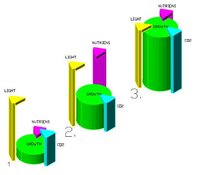Guys, it's unfortunate that you feel that way, and I'd have to apologize for contributing to the feeling of intimidation or that the feeling of being attacked by the brigade as James puts it. At no point have I or anyone attacked the low nutrient, non-CO2 approach. But that's not what the majority of people do. Most come to the forum with a high tank lighting far beyond reasonable levels. The preponderance of high light tanks is so massive that we have a low tech sub-forum, do we not? I mean, that's what people have chosen to do, use high lighting.
James, I think that you would agree that using a non-CO2 low nutrient approach with massive lighting is not as simple, and does not have a high probability of success. Normally, the first thing I look at when someone posts an issue with their tank is their level of lighting. But if they insist on using high lights, how else would you solve the problem? I think that's the key point. It's easy to suggest that they toss their CO2 and reduce their dosing, but if they choose not to reduce the lighting? Then what? Did we not agree that there should be a balance between the PAR energy levels and CO2/nutrients?
This is also complicated by the fact that many of those advocating low nutrients are doing so because of their fear of nutrient toxicity or that they merely automatically correlate nutrients with algae without having any knowledge or experience.
I think it unfair to accuse me of having the intent of intimidation. I'm happy to have anyone post their arguments but the proof of the pudding must be in their results. Also I feel that many of the nutrient reduction arguments are out of context with the OPs tank configuration or with their objectives. Darrel, you yourself have stated that you have never run a high tech tank, yet you offer advice (which seems to me) more appropriate to non-CO2 tanks when answering a question regarding a high light tank.
There are plenty of successful non-CO2 tanks out there, but I've not seen a whole lot of high light tanks run successfully using the low tech approach. The ADA approach is a low water column dosing approach, but that's made up for by use of an extremely nutrient rich sediment. It's also a very expensive approach. So where are we? An overwhelming majority of hobbyist who insist on using megawatts and CO2. Why wouldn't the preponderance of advice be similar?
Ha The High Priest of Nutrients/CO2 vs The Evil Empire of Huge Volumes of 150 Years of Scientific Data - I love it!
The High Priest of Nutrients/CO2 vs The Evil Empire of Huge Volumes of 150 Years of Scientific Data - I love it!
Cheers,
James, I think that you would agree that using a non-CO2 low nutrient approach with massive lighting is not as simple, and does not have a high probability of success. Normally, the first thing I look at when someone posts an issue with their tank is their level of lighting. But if they insist on using high lights, how else would you solve the problem? I think that's the key point. It's easy to suggest that they toss their CO2 and reduce their dosing, but if they choose not to reduce the lighting? Then what? Did we not agree that there should be a balance between the PAR energy levels and CO2/nutrients?
This is also complicated by the fact that many of those advocating low nutrients are doing so because of their fear of nutrient toxicity or that they merely automatically correlate nutrients with algae without having any knowledge or experience.
I think it unfair to accuse me of having the intent of intimidation. I'm happy to have anyone post their arguments but the proof of the pudding must be in their results. Also I feel that many of the nutrient reduction arguments are out of context with the OPs tank configuration or with their objectives. Darrel, you yourself have stated that you have never run a high tech tank, yet you offer advice (which seems to me) more appropriate to non-CO2 tanks when answering a question regarding a high light tank.
There are plenty of successful non-CO2 tanks out there, but I've not seen a whole lot of high light tanks run successfully using the low tech approach. The ADA approach is a low water column dosing approach, but that's made up for by use of an extremely nutrient rich sediment. It's also a very expensive approach. So where are we? An overwhelming majority of hobbyist who insist on using megawatts and CO2. Why wouldn't the preponderance of advice be similar?
Ha
Cheers,






